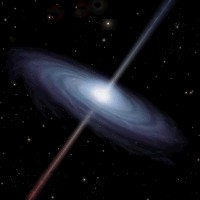RXTE Discoveries
RXTE Observation Helps Astronomers Link Galactic and Supermassive Black Holes February 1999
Astronomers have found similarities in both short-term and long-term X-ray fluctuations between apparent supermassive black holes in distant galaxies and smaller, well-studied stellar black holes in our galaxy. Such a link could help determine the mass of these more distant, elusive objects and eventually explain the exotic physical processes that produce the brilliant luminosity observed in the area around a black hole.
More specifically, RXTE observers Kirpal Nandra and Rick Edelson have found suggestive similarities in the timing properties of NGC 3516, an Active Galactic Nuclei (AGN) suspected of harboring a supermassive black hole, and Cygnus X-1, the prototypical galactic black hole. The flickering properties of the two objects are different by a factor of about one million, the same factor by which NGC 3516 is brighter than Cygnus X-1 in luminosity. If luminosity scales with mass, the result implies a mass for NGC 3516 of 10 million solar masses, in line with earlier estimates based on spectroscopic measurements.

|
Black holes are celestial objects with gravitational fields so powerful that nothing within a certain radius, including light, can escape. This radius is known as the Schwarzchild radius. A stellar black hole, often the end product of the lifecycle of a massive star, is an object with several times to a few dozen times the mass of the Sun. Galactic black holes, found at the center of a whole galaxy of hundreds of billions of stars, are supermassive, having a mass of hundreds of thousands to several billion times the mass of the Sun.
|
Why is the discovery of a method of measuring the mass of a galactic black hole so important? Dr. Rick Edelson, an astronomer working at University of California, Los Angeles, and Leicester University in the U.K., answers, "We have accurate ways of measuring the mass of stellar black holes from the orbits of their companion stars, which are affected by the black hole's mass and gravitational pull. But there's no way you can do that for a supermassive black hole. These variability characteristics [in X-ray fluctuation] may provide that link."
Drs. Edelson and Nandra (of NASA's Goddard Space Flight Center) used the Rossi X-ray Timing Explorer satellite to observe galaxy NGC 3516, which is located over 100 million light years from earth. Astronomers believe that this galaxy's exceptionally bright core, what is known as an Active Galactic Nucleus, is caused by a supermassive black hole, or "central engine," pulling matter from nearby stars with such fury that the energy produced in this relatively small region (the size of our solar system) outshines the entire galaxy.
Dr. Nandra's and Dr. Edelson's observations of NGC 3516 showed that it shares a surprising similarity in flickering properties (change of brightness over time) with Cygnus X-1, a nearby, well-studied stellar black hole located in our galaxy. The flickering of the two objects differs by a factor of about a million, which is the same difference in magnitude as their luminosities -- that is, NGC 3516 is about a million times brighter than Cygnus X-1.
Since luminosity is related to mass, the black hole masses should also differ by the same magnitude as their luminosities. This is just what the astronomers found: Cygnus X-1 at 10 solar masses and NGC 3516 at about 10 million solar masses match the estimates from earlier spectral studies that attempted to measure the mass of NGC 3516.
"These very strong similarities in the X-ray variability characteristics of supermassive and stellar black holes have never been measured before in such detail," said Nandra. "We now may be able to study by analogy many things about these more distant, supermassive black holes using our experience from stellar black holes, which are closer and better studied."
Nandra also said the flickering similarities suggest that the same physical mechanism may be working on both supermassive black holes in the cores of other galaxies and stellar black holes in our own galaxy.
This observation was possible because the astronomers took advantage of a property of RXTE's orbit. With low-orbit satellites like RXTE, which circles the earth every 96 minutes, most sources are blocked by the earth and unobservable for about half of each orbit. This makes it impossible to study the short time scale flickering. Edelson and Nandra noticed, however, that NGC 3516 is near the "pole" of the RXTE orbit, so it could be observed without interruption from earth occultation.
Edelson said that future missions, such as NASA's Chandra X-ray Observatory (formerly known as AXAF and scheduled for launch in mid-1999) will have high-earth orbits, so occultation won't be an issue and short time scale observations will be possible with many other galaxies. Edelson and Nandra will continue sampling X-rays from NGC 3516 about every four days for the next two years.


